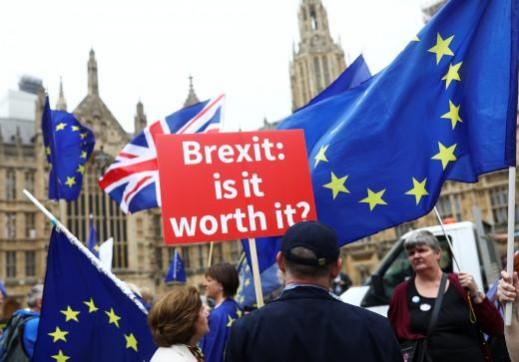
Tens of thousands of people took to the streets of London on Saturday demanding a second referendum on Brexit. Protestors demanded that the British government give people a chance to say whether or not Britain exits the European Union next year.
Organised by several pro-European campaign groups, it was dubbed the 'Peoples Vote March'. As per organisers, if Parliament rejects any deal, then citizens should have a say in the final terms of Brexit. Britain is formally due to leave the EU on March 29, 2019.
Beginning in London's Central Pall Mall street, protestors marched up to the Parliament square. The Metropolitan Police were dispatched to check violence, and luckily there were no untoward incidents. While neither the police nor the Westminister Council could provide official numbers, BBC says there were tens of thousands of people at the rally, as well as a much smaller crowd as part of a pro-Brexit protest.
Some protestors were okay with Brexit, as long as the British government had the final deal voted by the public, others, however, wanted a second referendum on whether Brexit should take place or not.
As the government struggles to come to a deal with the European Union, the economy has already taken a hit. Britain is currently having the slowest growing economy in Europe, and several companies, lead by BMW and Airbus have threatened to pull out of Britain should Brexit come into force without any safeguards.
The British Chambers of Commerce last week pegged economic growth at 1.3 percent a year, the lowest since the financial crisis.

Prime Minister Theresa May has been pushing for Britain to remain in the single market for goods but has faced backlash not just from home but also from the EU. This is in line with her promise to avoid a hard border between Ireland and Northern Ireland, a key point of contention for the government.
Britain's options
- Hard Brexit: This involves exiting the EU without any deals in place. For Britain, it would mean complete autonomy and freedom to make trade deals with other nations and function as per the UN trade laws. It, however, is the least desirable option since it would cause a hard border in Ireland, and force European citizens and companies to leave Britain en masse till the government negotiates deals with them, independently.
- Soft Brexit: A soft deal entails some form of relationship with the EU, mostly for free movement of people and certain goods. It would allow Britain to remain in the EU in certain areas, but provide them with a freedom to make deals out of the EU as well.
- Canda model: Britain could seek to have a trade deal much like Canda does with the EU, it is not a member of the bloc and restricts free movement, but has reduced tariffs through free trade deals.
- Norway model: Norway is not a member of the EU, but since it makes budgetary contributions to the bloc has no tariffs in place.





![Limited edition Phone (3a) launched in India; what's special about it [read now]](https://data1.ibtimes.co.in/en/full/825642/limited-edition-phone-3a-launched-india-whats-special-about-it-read-now.png?w=220&h=138)










